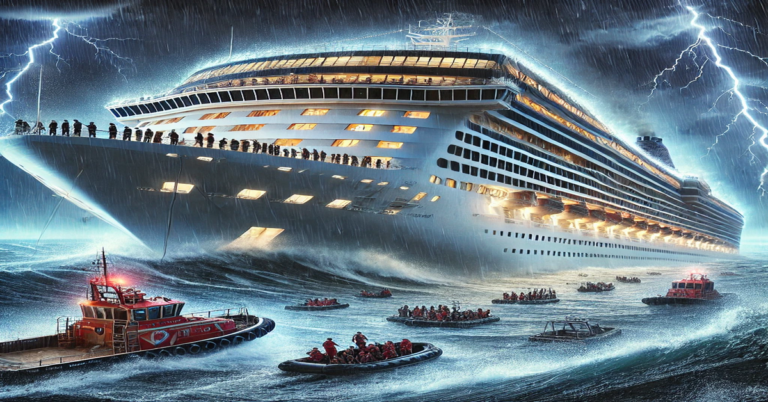The ocean has always been a place of adventure, mystery, and at times, unforeseen challenges. One of the most gripping tales of maritime travel involves the Cruise Ship Atlantic and its stranded passengers. This incident not only tested the resilience of those onboard but also highlighted crucial lessons for the cruise industry. In this article, we delve deep into the events surrounding the Cruise Ship Atlantic’s ordeal, examining the causes, the experiences of passengers, the response efforts, and the broader implications for cruise travel safety.
The Incident: What Happened?
The Cruise Ship Atlantic was on a transatlantic voyage, offering passengers a luxurious escape across the open seas. However, midway through its journey, the ship encountered a series of mechanical failures that left it stranded in the middle of the Atlantic Ocean.
Timeline of Events:
- Departure: The ship departed from its homeport with over 3,000 passengers and crew onboard, destined for a European port.
- Mechanical Failure: Approximately five days into the voyage, a critical engine malfunction halted the ship’s progress.
- Communication Breakdown: Initial delays in notifying authorities exacerbated the situation, leaving passengers uninformed.
- Adverse Weather: To make matters worse, a sudden storm in the region intensified the challenges faced by the crew and passengers.
The Passenger Experience
The days spent stranded were grueling for passengers, who faced a mix of physical and emotional challenges.
1. Living Conditions:
Without a functional propulsion system, the ship’s energy supply was severely limited, affecting:
- Air Conditioning: Many cabins became stiflingly hot due to a lack of ventilation.
- Water Supply: Limited access to running water disrupted hygiene and sanitation.
- Food Supply: Although the crew worked tirelessly, food rationing became necessary.
2. Emotional Impact:
The uncertainty and isolation took a toll on passengers, leading to:
- Anxiety and stress about their safety.
- Frustration over the lack of timely information.
- Solidarity among passengers as they supported one another through the ordeal.
The Crew’s Response
The crew played a pivotal role in ensuring the safety and well-being of those onboard. Despite limited resources, their efforts were commendable in several ways:
- Emergency Protocols: The crew implemented safety measures to prevent panic and maintain order.
- Communication Efforts: While there were initial delays, regular updates were eventually provided to passengers.
- Medical Assistance: Onboard medical teams addressed health concerns, particularly for elderly passengers and those with pre-existing conditions.
Rescue Operations
After days of drifting, a coordinated rescue effort was launched involving multiple agencies.
1. Response Teams:
Coast guards, naval ships, and private vessels from nearby nations collaborated to reach the stranded ship.
2. Passenger Evacuation:
Evacuation procedures prioritized vulnerable groups, including children, the elderly, and those with medical needs.
3. Ship Towing:
A specialized tugboat was deployed to tow the Cruise Ship Atlantic to the nearest port, where repairs could be undertaken.
Causes of the Incident
A thorough investigation revealed multiple factors that contributed to the incident:
- Mechanical Issues: The engine failure was attributed to inadequate maintenance and outdated components.
- Weather Challenges: The storm, though unforeseen, highlighted the importance of real-time weather monitoring.
- Communication Gaps: Delays in notifying authorities and passengers created unnecessary confusion and anxiety.
Lessons for the Cruise Industry
The Cruise Ship Atlantic incident underscored several lessons for the cruise industry:
- Preventive Maintenance: Regular inspections and upgrades are essential to avoid mechanical failures.
- Crisis Communication: Transparent and timely communication builds trust and reduces panic during emergencies.
- Passenger Preparedness: Educating passengers about safety protocols can empower them to respond effectively in crises.
- Collaboration: Partnerships with international maritime agencies can expedite rescue operations.
Broader Implications for Travel Safety
The incident sparked discussions about improving safety standards across the travel industry. Key takeaways include:
- Technology Integration: Advanced monitoring systems can detect potential issues before they escalate.
- Sustainability: Modernizing ships with energy-efficient and reliable technologies reduces the risk of failures.
- Global Cooperation: Strengthened international frameworks can ensure rapid response to maritime emergencies.
Current Status of the Cruise Ship Atlantic
Following the incident, the cruise ship atlantic stranded passengers underwent extensive repairs and upgrades. The ship has since returned to service, with enhanced safety measures and improved facilities. Passengers and crew now benefit from:
- State-of-the-Art Equipment: Upgraded engines and navigation systems ensure smoother operations.
- Enhanced Training: Crew members receive regular training in emergency response and crisis management.
- Passenger Support: Onboard resources for passenger welfare, including counseling and medical facilities, have been expanded.
FAQs About the Cruise Ship Atlantic Incident
1. What caused the Cruise Ship Atlantic to become stranded?
The incident was caused by a combination of mechanical failure, adverse weather, and delayed communication.
2. How long were passengers stranded?
Passengers were stranded for approximately five days before rescue operations were successfully completed.
3. Were there any injuries during the incident?
While there were no severe injuries, some passengers experienced health issues related to heat, stress, and limited resources.
4. What measures have been implemented to prevent similar incidents?
The cruise line has upgraded its ships, improved maintenance schedules, and enhanced crew training in crisis management.
5. How did passengers cope with the situation?
Passengers showed resilience, supporting one another while relying on the crew’s efforts to maintain safety and order.
6. Is the Cruise Ship Atlantic still in operation?
Yes, the ship has returned to service with upgraded systems and enhanced safety measures.

